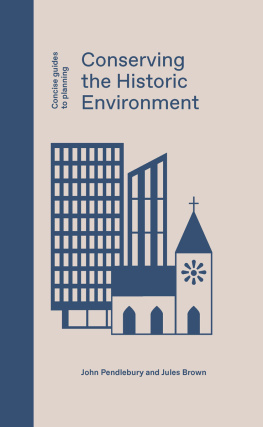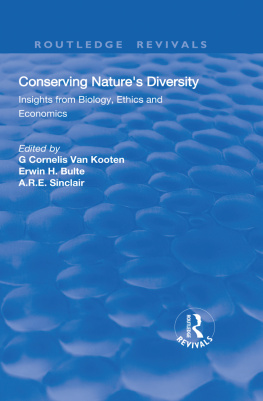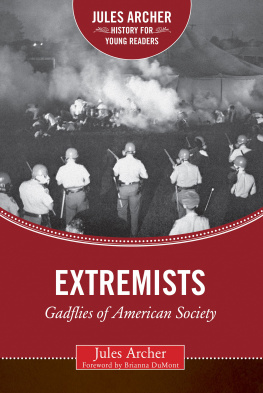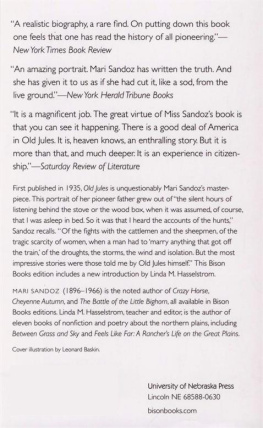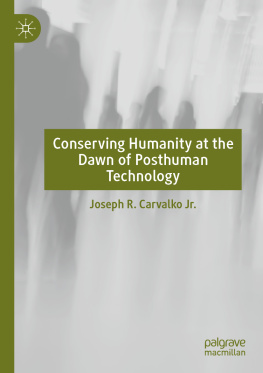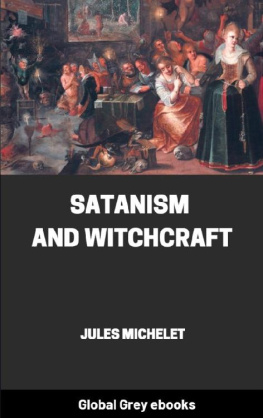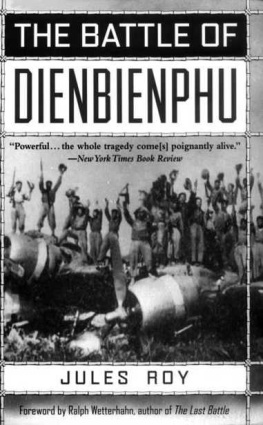First published in 2021 by Lund Humphries
Lund Humphries
Office 3, Book House
261A City Road
London EC1V 1JX
UK
www.lundhumphries.com
Conserving the Historic Environment
John Pendlebury with Jules Brown, 2021
All rights reserved
ISBN (hardback): 9781848222991
ISBN (eBook PDF): 9781848223066
ISBN (eBook ePub): 9781848223073
ISBN (eBook Mobi): 9781848223080
Concise Guides to Planning (Print): ISSN 25168177
Concise Guides to Planning (Online): ISSN 25168185
A Cataloguing-in-Publication record for this book is available from the British Library.
All rights reserved. No part of this publication may be reproduced, stored in a retrieval system or transmitted in any form or by any means, electrical, mechanical or otherwise, without first seeking the permission of the copyright owners and publishers. Every effort has been made to seek permission to reproduce the images in this book. Any omissions are entirely unintentional, and details should be addressed to the publishers.
John Pendlebury and Jules Brown have asserted their right under the Copyright, Designs and Patent Act, 1988, to be identified as the Authors of this Work.
Cover design by Stefi Orazi
Copy edited by Pamela Bertram
Typeset by Jacqui Cornish
Proofread by Patrick Cole
Set in Favorit
Printed in the United Kingdom
Image credits: The reproduction of the figures listed below is courtesy of the following copyright holders: Australia ICOMOS, https://australia.icomos.org/publications/burra-charter-practice-notes/ 3.1; Ben Graham 8.1; C. Wilkins et al. (2011) 7.5; Cultura Trust (formerly North East/North of England Civic Trust) 3.4; Dag Nilsen 7.2; Devon County Council 5.1; Edward James 7.4; Historic England 2.3; Historic Coventry Trust 6.1; John Pendlebury 1.1, 1.2, 1.3, 1.4, 1.5, 1.6, 1.7, 1.8, 1.9, 1.10, 1.11, 1.12, 2.1, 2.4, 2.5, 3.5, 4.5, 5.2, 5.4, 5.5, 5.6, 5.7, 5.8, 5.9, 5.11, 6.2, 6.3, 6.4, 6.5, 6.6, 7.1, 7.3; Jules Brown 3.2, 5.10; Kasia Pendlebury 5.3; Maciej Czeredys 2.2; Martin Hulse 4.6; Newcastle City Council and Cultura Trust (formerly North East/North of England Civic Trust) 3.3; Prue Chiles 4.4; Simpson & Brown 4.1, 4.2, 4.3.
Contents
Foreword by Graham Haughton
Preface and Acknowledgements
A note on organisations and organisational change
Chapter 1 Introduction
The development of state protection and categories of protection
Focus of the book
A note on further reading for this chapter and the book as a whole
Chapter 2 Theories of Conservation
Introduction
Origins
Consolidating conservation principles
Values-based approaches
Critical heritage studies
Conclusion
Further reading
Chapter 3 Principles of Research, Analysis and Management
Introduction
Finite and valued resource and the inevitability of change
From principles to practice
Conservation decision-making
Understanding
Significance
Risks and issues
Setting down policy and action
Conclusion
Further reading
Chapter 4 Managing Change in Historic Buildings
Introduction
Understanding buildings
Maintaining and using buildings: repair and restoration
Managing change: adaption and reuse
Regulation
Proactive management
Conclusion
Further reading
Chapter 5 Managing Change in Historic Areas
Introduction
Understanding conservation areas: urban morphology and townscape
Managing conservation areas
Conservation areas and urban planning
The management of urban World Heritage Sites
Conclusion
Further reading
Chapter 6 Conserving the Heritage of Modernity
Introduction
The protection of modern heritage
Managing modern heritage
Valuing use in modern heritage
Conclusion
Coda
Further reading
Chapter 7 The Historic Environment and Sustainable Development
Introduction
Economic sustainability
Social sustainability and wellbeing
Environmental sustainability
Conclusion
Further reading
Chapter 8 Conservation Today and Tomorrow
Today
Tomorrow
Bibliography
Foreword
Conserving the Historic Environment is a real tour de force, bringing together a wealth of expertise and experience accumulated over many years, combining the best of academic rigour and practitioner engagement. It guides the reader through the history and theory of conservation, then engages with some of the key management issues for those involved in seeking to conserve diverse historic environments. The book concludes with highly topical chapters on the complexities of dealing with modernist buildings and sustainable development before reflecting on the present and future of conservation planning practice.
John Pendlebury and Jules Browns work will be valuable both to those with little experience of conservation planning but wishing to know more and those with more experience who want to get up to speed with current practice and scholarship. It will also be a valuable resource for students in a variety of disciplines planning, geography and history, for instance wanting to know more about conservation issues.
I really hope too that it will find a wider readership within the general public, political decision-makers and all those interested in how we deal with the tensions that run through conservation planning. This book helps all of us to consider how best to preserve sensitively the best of the past, in ways that allow us to continue to build and improve attractive areas in which to live and work places that bring joy to those who live in, work in and visit them.
With a wealth of case studies and illustrative materials the book is a joy to read, easy to follow, up to date and simply interesting in its own right. I loved reading it and I hope you will too.
Graham Haughton, Series Editor
Preface and Acknowledgements
This book has been written by an academic and a practitioner. This combination is not without its challenges! While technical knowledge is important in conserving the historic environment, it is by no means purely a technical practice. In undertaking this work, we inevitably use value judgements, and values are not always shared. In recent decades conservation of the historic environment has arguably been one of the less contentious elements of the planning system. However, at the same time, in the wider field of heritage studies, academics have been busy critiquing heritage practices. While these debates can seem far removed from day-to-day management, one of the purposes of this book is to connect these together. And because values and opinions differ it is worth being explicit about our position within these debates, although how we think about heritage is not precisely the same between us.



